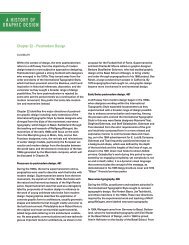Week 12 The Asian Contribution - A History of Graphic Design
Week 12 The Asian Contribution - A History of Graphic Design
Week 12 The Asian Contribution - A History of Graphic Design
You also want an ePaper? Increase the reach of your titles
YUMPU automatically turns print PDFs into web optimized ePapers that Google loves.
A HISTORY OF<br />
GRAPHIC DESIGN<br />
Chen-shu or kai-shu, (regular style), has been in continuous use for nearly two thousand years. Every line, dot, and nuance<br />
<strong>of</strong> the brush can be controlled by the sensitivity and skill <strong>of</strong> the calligrapher. It is considered the highest art form<br />
in China, more important even than painting (Fig. 3-5).<br />
Li, the prehistoric character for the three-legged pot, which is now the word for tripod (Fig. 3-6).<br />
Tao, the cosmic spirit in Chinese culture that operates throughout the universe in animate and inanimate things.<br />
Chop, a seal made by carving calligraphic characters into a flat surface <strong>of</strong> jade, silver, gold, or ivory. <strong>The</strong> raised surface<br />
is inked and the image is transferred to paper by stamping. (Fig. 3- 10).<br />
Cinnabar, a substance used to make a paste-like red ink for stamping.<br />
Woodblock printing, pages 40, 45: <strong>The</strong> negative space around characters and images are carved away from the wood.<br />
Ink is then applied to the wood, and it is pressed onto paper or other substrates to print the image (Fig. 3-16).<br />
Relief printing, <strong>The</strong> spaces around an image on a flat surface are cut away, the remaining raised surface is inked, and<br />
the inked image is transferred to the paper.<br />
Dharani, Buddhist charms printed and placed in pagodas to help lengthen one’s life and eventually lead to paradise<br />
(Fig. 3-14).<br />
Diamond Sutra, the oldest surviving printed manuscript, consisting <strong>of</strong> seven sheets <strong>of</strong> paper pasted together to form a<br />
scroll conveying Buddha’s revelations to his elderly follower Subhuti (Fig. 3-15).<br />
Accordion-style book, folded book resembling a scroll that was folded like a railroad timetable instead <strong>of</strong> rolled.<br />
Codex-style book, stitched book with sequences <strong>of</strong> two pages <strong>of</strong> text printed from one block, then folded down the<br />
middle with the unprinted side <strong>of</strong> the sheet facing inward and the two printed pages facing out.<br />
Pen ts’ao, a medical book on herbs with illustrations and calligraphy used for headings and a graphic design grid system<br />
used to separate the text into sections shown in the center <strong>of</strong> the right-hand page (Fig. 3-17).<br />
Movable type, in Asia, single characters made individually in a mixture <strong>of</strong> clay and glue and arranged side by side to<br />
compose full lines <strong>of</strong> text (Fig. 3-19).<br />
KEY PEOPLE AND THEIR MAJOR CONTRIBUTIONS (IN ORDER OF APPEARANCE; THE FIRST PAGE NUMBER OF THEIR<br />
APPEARANCE IS LISTED)<br />
Ts-ang Chieh, inspired in about 1800 bce to invent writing by contemplating the claw marks <strong>of</strong> birds and footprints <strong>of</strong><br />
animals, then developing elementary pictographs <strong>of</strong> things in nature.<br />
Prime Minister Li Ssu (c. 280–208 bce), charged with designing the new standardized writing style, hsiao chuan.<br />
Li Fangying ( 1695–1754 ce), wrote and illustrated the Album <strong>of</strong> Eight Leaves, showing how the vividly descriptive<br />
strokes <strong>of</strong> a bamboo brush join calligraphy, painting, poem, and illustration, into a unified communication (Fig. 3-7).<br />
Ts’ai Lun, the eunuch and high governmental <strong>of</strong>ficial credited with inventing paper.<br />
Pi Sheng (1023–1063 ce), Chinese alchemist who developed the concept <strong>of</strong> movable type.
















